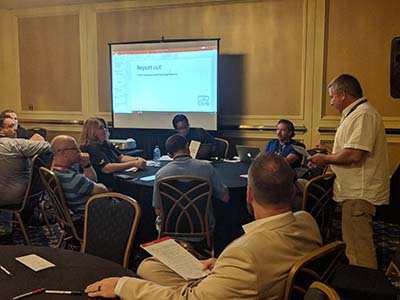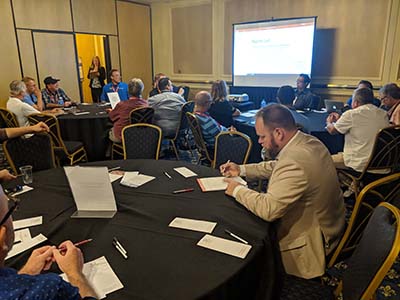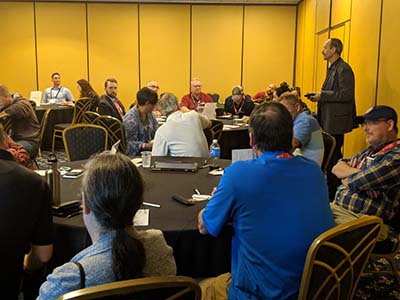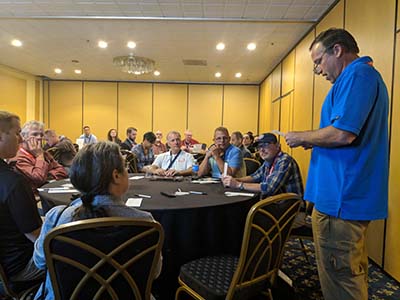It’s no secret that drones are disrupting and changing the way people in numerous industries can approach a given task or project. However, ensuring that the next generation both understands and can take advantage of these disruptions means that there needs to be an active effort to provide education around how things are changing in construction, agriculture, utilities, mapping and surveying, fire science, search and rescue, photography and videography, and other sectors. Thankfully, doing so is an initiative that educators have made a priority.
At the recent Commercial UAV Expo in Las Vegas, a university roundtable facilitated by Kenneth Yanow (Associate Director) and Wing Cheung (Assistant Director) of the National Science Foundation (NSF) National Geospatial Technology Center of Excellence (the GeoTech Center), focused on ideas and issues related to teaching drone technology and applications at 2-year and 4-year institutions of higher education. The session, organized by Wing Cheung and Kat McDonald of Diversified Communications, covered topics such as program & curriculum development, preparing students for the workforce, and qualifications for instructors teaching within these programs. Some highlights and key takeaways from the session are summarized below. Creating a Path to Success with DronesOne obstacle faced by some in the university market is the need to dispel false notions that can stigmatize drones, such as the idea that drones aren’t much more than fancy toys. Doing so is sometimes just a matter of creating greater awareness of drone tech to students at all levels. That said, numerous participants of the roundtable cautioned against marketing drone education courses as a career-making strategy. Rather, for many disciplines, drones are a powerful tool to assist in data collection (such as precision agriculture and environmental mapping) and/or payload delivery (such as pesticides or fire repellent). In this regard, students across a variety of disciplines should consider taking drone technology and application courses for their specific major.As with the promotion of STEAM (Science, Technology, Engineering, Arts, and Math) in all education levels, including K-12, roundtable participants found similar needs in drone technology and applications. They encouraged educators at all levels to create “drone pathways” that will enable even very young students to follow a professional path into drone tech. Creating adequate and malleable coursework still remains a challenge.David Thirtyacre, of ERAU, spoke about curriculum development and instructor qualifications, noting the importance of what department a college’s drone program is housed under (and why), as well as the advantages of having a department that’s dedicated to drone technology. For example, if a drone course is offered within a geography department, then instructors generally must have the necessary qualifications to teach geography coursework. Thirtyacre also noted that schools who choose to create a drone education program need to create their courses and programs that are responsive to industry needs.Whether they are classes on drone maintenance, the use of military drones, small UAS business entrepreneurship, or some other topics, the coursework a college or university chooses for a drone program will determine the success of that program. Instructors are just as important as the classes, raising questions of standards of qualifications for drone tech instructors. These and other questions belied the ever-changing nature of the still-emerging field of drone technology and applications, but also showcase what a path to success with the technology can look like.
Creating a Path to Success with DronesOne obstacle faced by some in the university market is the need to dispel false notions that can stigmatize drones, such as the idea that drones aren’t much more than fancy toys. Doing so is sometimes just a matter of creating greater awareness of drone tech to students at all levels. That said, numerous participants of the roundtable cautioned against marketing drone education courses as a career-making strategy. Rather, for many disciplines, drones are a powerful tool to assist in data collection (such as precision agriculture and environmental mapping) and/or payload delivery (such as pesticides or fire repellent). In this regard, students across a variety of disciplines should consider taking drone technology and application courses for their specific major.As with the promotion of STEAM (Science, Technology, Engineering, Arts, and Math) in all education levels, including K-12, roundtable participants found similar needs in drone technology and applications. They encouraged educators at all levels to create “drone pathways” that will enable even very young students to follow a professional path into drone tech. Creating adequate and malleable coursework still remains a challenge.David Thirtyacre, of ERAU, spoke about curriculum development and instructor qualifications, noting the importance of what department a college’s drone program is housed under (and why), as well as the advantages of having a department that’s dedicated to drone technology. For example, if a drone course is offered within a geography department, then instructors generally must have the necessary qualifications to teach geography coursework. Thirtyacre also noted that schools who choose to create a drone education program need to create their courses and programs that are responsive to industry needs.Whether they are classes on drone maintenance, the use of military drones, small UAS business entrepreneurship, or some other topics, the coursework a college or university chooses for a drone program will determine the success of that program. Instructors are just as important as the classes, raising questions of standards of qualifications for drone tech instructors. These and other questions belied the ever-changing nature of the still-emerging field of drone technology and applications, but also showcase what a path to success with the technology can look like. Data and DronesCarl Salvaggio, of Rochester Institute of Technology, led a discussion on data calibration and processing pipelines, noting the use of specialized sensors (e.g. multispectral, hyperspectral, LiDAR) in fields such as precision agriculture and environmental science, and the significance of radiometric and geometric calibration in data processing workflows.While sensors are an integral part of data collection with drones, it is just as important to grasp what the data represents and potential limitations. An incomplete understanding of photogrammetry and data accuracy can potentially lead to the misinterpretation of final outputs and cause confusion in the decision making process. Thus, coursework in these areas should be considered a critical element in the integration of drones for commercial and professional applications.Making a fit for drones in the classroomWhat does it mean to create the right fit for students within a program? The answer depends on the focus of the drone program. These and other questions were covered in a roundtable on assessment and recruitment of potential students, led by Riley Beaman, of Montgomery Community College.Because the UAS industry (especially the small UAS industry) is so new and ever-changing, how can a school develop and market its drone program? A good starting point includes properly naming the program and thoroughly detailing the program’s purpose. Strategies for recruitment should try to maximize student diversity by implementing a variety of outreach strategies, as well as creating academic pathways between high schools, colleges, and universities. Strategies for retention should include coursework that is both workforce relevant and contextual (i.e., shows the value of drone technology for specific applications).Attracting the right students, while crucial, is just one part of an educator’s task. How do they assess their drone tech programs/courses to determine student readiness to join the workforce? Part of the answer could be in continually assessing program learning outcomes, as properly preparing students for the workforce depends upon the objectives of the drone program. Many industries have uses for UASs, and students may not know what industries are using this technology. Therefore, providing a broad overview of the industry might be a starting point for some programs.The current (and future) drone workforce includes everything from robotics and computer programming to emergency response and geographic information systems (GIS). Students will also need skills and competencies such as professionalism and reliability (i.e. “soft skills”). As the industry and regulations regarding drone operations move foward, it is important for instructors, courses, and programs to stay current with industry needs.
Data and DronesCarl Salvaggio, of Rochester Institute of Technology, led a discussion on data calibration and processing pipelines, noting the use of specialized sensors (e.g. multispectral, hyperspectral, LiDAR) in fields such as precision agriculture and environmental science, and the significance of radiometric and geometric calibration in data processing workflows.While sensors are an integral part of data collection with drones, it is just as important to grasp what the data represents and potential limitations. An incomplete understanding of photogrammetry and data accuracy can potentially lead to the misinterpretation of final outputs and cause confusion in the decision making process. Thus, coursework in these areas should be considered a critical element in the integration of drones for commercial and professional applications.Making a fit for drones in the classroomWhat does it mean to create the right fit for students within a program? The answer depends on the focus of the drone program. These and other questions were covered in a roundtable on assessment and recruitment of potential students, led by Riley Beaman, of Montgomery Community College.Because the UAS industry (especially the small UAS industry) is so new and ever-changing, how can a school develop and market its drone program? A good starting point includes properly naming the program and thoroughly detailing the program’s purpose. Strategies for recruitment should try to maximize student diversity by implementing a variety of outreach strategies, as well as creating academic pathways between high schools, colleges, and universities. Strategies for retention should include coursework that is both workforce relevant and contextual (i.e., shows the value of drone technology for specific applications).Attracting the right students, while crucial, is just one part of an educator’s task. How do they assess their drone tech programs/courses to determine student readiness to join the workforce? Part of the answer could be in continually assessing program learning outcomes, as properly preparing students for the workforce depends upon the objectives of the drone program. Many industries have uses for UASs, and students may not know what industries are using this technology. Therefore, providing a broad overview of the industry might be a starting point for some programs.The current (and future) drone workforce includes everything from robotics and computer programming to emergency response and geographic information systems (GIS). Students will also need skills and competencies such as professionalism and reliability (i.e. “soft skills”). As the industry and regulations regarding drone operations move foward, it is important for instructors, courses, and programs to stay current with industry needs. Preparing students for the commercial workforceTo adequately prepare drone tech students for the commercial workforce, minimum qualifications for an entry-level drone operator must be established. Those qualifications could be partly delineated by the FAA’s relatively new Part 107 regulations. Terry Brase, of West Hills College, led a roundtable on preparing students for the commercial workforce; discussing essential skills for an entry-level drone operator.The successes of many academic programs are defined by their outcomes, including whether or not students enter into the drone industry (or into a discipline that uses drone technology applications). Those outcomes will be at least partly determined by students’ and graduates’ ability to meet employer needs, such as the ability to generate specific types of output (e.g. videos, 3D models, and maps) and meet data quality requirements. It is important that students of today and tomorrow be taught industry-specific competencies and skills.The question of using drones in-house or outsourcing the work to consultants was also a key issue for some participants. It was noted that for a variety of reasons (liability, limited staff), the outsourcing of drone work is trending, which may result in more employment opportunities for students and entrepreneurs.So, in addition to attracting students, drone educators need the feedback from industry leaders to ensure that students are prepared for the workforce when they graduate. Currently, the drone sector is short on apprenticeships, internships and other “learn as you earn” opportunities, which may be hindering entry into this new and exciting industry.
Preparing students for the commercial workforceTo adequately prepare drone tech students for the commercial workforce, minimum qualifications for an entry-level drone operator must be established. Those qualifications could be partly delineated by the FAA’s relatively new Part 107 regulations. Terry Brase, of West Hills College, led a roundtable on preparing students for the commercial workforce; discussing essential skills for an entry-level drone operator.The successes of many academic programs are defined by their outcomes, including whether or not students enter into the drone industry (or into a discipline that uses drone technology applications). Those outcomes will be at least partly determined by students’ and graduates’ ability to meet employer needs, such as the ability to generate specific types of output (e.g. videos, 3D models, and maps) and meet data quality requirements. It is important that students of today and tomorrow be taught industry-specific competencies and skills.The question of using drones in-house or outsourcing the work to consultants was also a key issue for some participants. It was noted that for a variety of reasons (liability, limited staff), the outsourcing of drone work is trending, which may result in more employment opportunities for students and entrepreneurs.So, in addition to attracting students, drone educators need the feedback from industry leaders to ensure that students are prepared for the workforce when they graduate. Currently, the drone sector is short on apprenticeships, internships and other “learn as you earn” opportunities, which may be hindering entry into this new and exciting industry. Drone programs that are built to lastWhile not a legal requirement, college drone programs should protect themselves and their assets by getting liability insurance. In addition to getting coverage, some also might want to consider getting an aviation policy for their university. The best way to determine which coverage (and how much) your school needs is by speaking with your campus risk manager to determine how to proceed.Schools should also consider scenario planning and crisis management tactics. Eric Delucien, University of California San Diego, suggested having a “call out” list, detailing whom to call in an emergency or accident, is a must. It’s also important to have some sort of prepared statement for the media in case of an accident. Perhaps just as crucial is the need to have a chain of command in such a scenario. People on staff need to know who will enforce the school’s drone policy, and who will speak for the school in the event of a drone-related crisis.Drone tech educators should remember that there are local and state policies (such as the good neighbor policy), in addition to FAA policies that govern drone use, and educators should always get proper permission for flights when possible. They should be proactive with local law enforcement and establish good communications between campus departments.As more universities look to implement programs that are dedicated to or integrated with UAS technology, faculty and administrators need to consider the programs’ short-term and long-term liability and legal ramifications. These are details that will need to be continually assessed as the technology and legal landscape evolve. To learn more about or take part in the next University Roundtable, click here.
Drone programs that are built to lastWhile not a legal requirement, college drone programs should protect themselves and their assets by getting liability insurance. In addition to getting coverage, some also might want to consider getting an aviation policy for their university. The best way to determine which coverage (and how much) your school needs is by speaking with your campus risk manager to determine how to proceed.Schools should also consider scenario planning and crisis management tactics. Eric Delucien, University of California San Diego, suggested having a “call out” list, detailing whom to call in an emergency or accident, is a must. It’s also important to have some sort of prepared statement for the media in case of an accident. Perhaps just as crucial is the need to have a chain of command in such a scenario. People on staff need to know who will enforce the school’s drone policy, and who will speak for the school in the event of a drone-related crisis.Drone tech educators should remember that there are local and state policies (such as the good neighbor policy), in addition to FAA policies that govern drone use, and educators should always get proper permission for flights when possible. They should be proactive with local law enforcement and establish good communications between campus departments.As more universities look to implement programs that are dedicated to or integrated with UAS technology, faculty and administrators need to consider the programs’ short-term and long-term liability and legal ramifications. These are details that will need to be continually assessed as the technology and legal landscape evolve. To learn more about or take part in the next University Roundtable, click here.















Comments